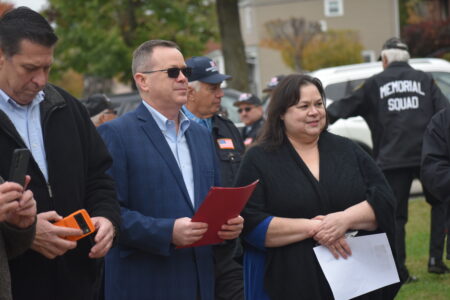City of Wheeling Taking Ownership of Former Clay School

Photo by Eric Ayres - The former Clay School building on 15th Street in East Wheeling has sat virtually vacant for decades since the last school bell rang there in the 1990s.
WHEELING — The former Clay School’s recent history of continuous deterioration may soon be coming to an end as the city of Wheeling is in the process of taking ownership of the landmark East Wheeling structure.
In recent years, the vacant school building on 15th Street has generated mild interest from developers, but nothing has come to fruition. The hulking brick structure served the East Wheeling community as an elementary through junior high school building for decades before the doors were shuttered in the 1990s.
This week, members of Wheeling City Council passed a resolution accepting the transfer of several parcels of property at the intersection of 131-15th Street — the former Clay School building campus — at no cost. The city is expected to take ownership of the property and assume any fire service fees outstanding.
Ward 3 Councilwoman Rosemary Ketchum spoke of dilapidated buildings in the neighborhood and the ongoing need to clean up blight in her ward and in other parts of the city.
“In talking about cleaning up blighted properties in East Wheeling and throughout Ward 3, the former Clay School building — which most folks might be familiar with depending on your age, maybe — has been a property in East Wheeling for many, many years and has served families in the neighborhood of East Wheeling — particularly Black families,” Ketchum said.
After the Clay School building closed and students relocated to other school facilities in the city, Darryl Baynes later took ownership of the building with the intention of transforming it into a youth science and community center. According to the resolution passed this week, the transfer of ownership is being coordinated with Bayne’s Minority Aviation Education Association Inc.
A sustainable use for the structure has not been realized, however, and over the past two decades, only one promising out-of-town development proposal provided hope for the property. However, the deal to redevelop the property into a housing development never materialized.
“Since its last purchase in the early 2000, it’s sat relatively without use and subject to all kinds of weather and moisture, and I think in our efforts to beautify and clean up our communities, this transfer of property is an example of getting it right and addressing a property that really needs our help,” Ketchum said.
Wheeling Mayor Glenn Elliott this week said over the past several years, developers have been taken through the Clay School, while the city, owner and developers have sought to find some “realistic win-win outcomes” for the property. But there has been no such luck.
“We actually had a developer from Chicago very interested in the project,” Elliott said. “We just couldn’t make the numbers work in a way that made sense for the city. It’s a tough building to save. It was built during World War II, and some of the materials that were used, I guess, were not ideal, and it has not held up very well. Some of the most interesting architectural features were removed by the current owner — some of the facade reliefs. It’s a building that’s just challenging to save.”
The former Clay School building towers on 15th Street over the J.B. Chambers Sports Complex and football field, which some describe as a gem of a new community recreation facility surrounded by many blighted properties.
The mayor indicated that the spark of revitalization brought forth by the sports complex should continue with other positive developments in the area. The redevelopment of the Clay School property could be the next big step, he noted. Officials stated that the huge, four-story building has a footprint of 30,000-square-foot.
“It is right next to a major city investment — the sports field right next door — and currently, (the Clay School) stands there with a lot of broken windows, and it doesn’t reflect well on this neighborhood,” Elliott said. “It’s my understanding that the current owner is not in a position to do anything that’s going to save that building, and if the city doesn’t act, it’s probably going to sit there for another extended period of time and continue to bring blight to that community. So I think it’s a situation where we have no other option before us, and I think it’s on us to figure out a good way to move forward.”
Council members unanimously supported the resolution regarding the transfer of ownership of the property. City Manager Robert Herron noted that once the city takes ownership and assesses the status of the building, city leaders will likely explore options to either redevelop the facility or demolish the structure and ready the property for potential new development.






